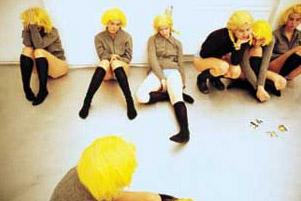July 30, 2004
On Liveness and Presence
What is Live Art?
This from the UK: "Unlike with opera, people often ask, 'What is Live Art?' The answer is people have been experiencing it for the last hundred years, from the earliest events at the Cabaret Voltaire where DADA was born to the happenings of the Sixties which influenced Andy Warhol, and in the 21st century this tradition continues to mutate." 
Today Live Art is witnessed at perfomances by Vanessa Beecroft or The Battle of Orgreave by Jeremy Dellar. Live Art is an interrogation of the aesthetics of presence. Live Art is about being there.
"Live Art mixes genres and diverse cultural experiences to express the complex organisation of contemporary life. It often involves work which questions commonly held assumptions. Live art is the trash-can of culture recycling and celebrating the debris of the modern world."
The History
: In 1965 Kaprow explained his evolution from collage to environments and happenings: "The action collages then became bigger, and I introduced flashing lights and thicker hunks of matter. These parts projected further and further from the wall into the room, and included more and more audible elements: sounds of ringing buzzers, bells, toys, etc., until I had accumulated nearly all the sensory elements I was to work with during the following years...." His works expanded until they filled the gallery, creating an integrated environment for the spectator. "I immediately saw that every visitor to the environment was part of it. And so I gave him opportunities like moving something, turning switches on -- just a few things. Increasingly during 1957 and 1958, this suggested a more 'scored' responsibility for the visitor. I offered him more and more to do until there developed the Happening...The integration of all elements -- environment, constructed sections, time, space, and people -- has been my main technical problem ever since."
Kaprow's progress did not occur in a vacuum, as he readily acknowledges. Robert Rauschenburg, Claes Oldenburg, and Jim Dine, among others, were also working on theatrical pieces, although they soon returned to more traditional areas; In Europe, Wolf Vostell and the Fluxus Group, and in Japan, the Gutai Group, were all investigating similar directions.
The Theory of Happenings: The Happening, as Kaprow developed it, is a non-verbal, theatrical production that abandons stage-audience structure as well as the usual plot or narrative line of traditional theatre. Although a compartmented organization may be used, the performers are considered as objects -- often kinaesthetically involved -- within an overall design of environment, timing, sound, colour and light. Found environments are often used and built upon, but the events are not casually arrived at, nor are they entirely accidental and spontaneous.
His view was that the Assemblage was to be "handled and walked around", the environment" was to be "walked into", but the happening was to be a genuine "event" involving spectator participation and no longer confined to the museum or gallery. Performers are encouraged to capitalize upon unplanned occurrences while acting out fantasies based on real life within a certain roughly pre-ordained structure that suggests symbolic and universally basic themes and meanings. A field of aesthetic operation is thus created in relation to life, combining artfully determined materials with strong associational properties, and dimensions with events and things from the sphere "outside" of customary definitions for art.
In the following networked performance types we directly see the influence of happenings particularly in the emergence of wireless network enabled Urban Gaming such as the Go Game. Go Game started off as a bunch of digerati having fun with their handhelds. Then it started becoming popular so the developers began marketing their services as event producers to corporations. Now their website has this decidedly corporate slant.
Pac-Manhattan was developed out of the NYU Interactive media program...possibly interesting if it doesn't fizzle out....
Urban Challenge, urrr I guess it's now Verison Urban Challenge. Enough said.
FlashMobs have matured to smart mobs.
GeoCaching is an entertaining adventure game for GPS users. Participating in a cache hunt is a good way to take advantage of the wonderful features and capability of a GPS unit. The basic idea is to have individuals and organizations set up caches all over the world and share the locations of these caches on the internet. GPS users can then use the location coordinates to find the caches. Once found, a cache may provide the visitor with a wide variety of rewards. All the visitor is asked to do is if they get something they should try to leave something for the cache.
Posted by michelle at July 30, 2004 11:40 AM
